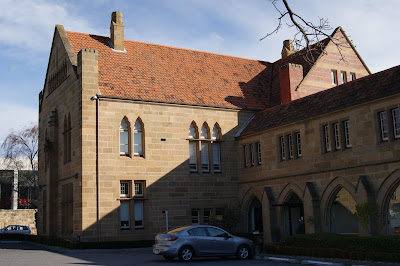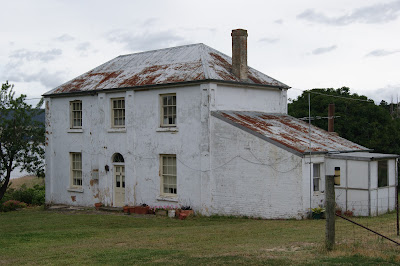In 1838, the then Lieutenant Governor, Colonel Arthur, granted the use of a building on the New Wharf, formerly occupied for government purposes, which was fitted up as a Bethel Chapel, and in which religious services were conducted on Sunday afternoons, for the especial benefit of seamen, the officiating ministers being those connected with the different churches of Hobart Town. The opening services at the Bethel were in April, 1838, when sermons were preached, in the morning by the Rev. W. Hurst, and in the afternoon by the Rev. Frederick Miller. Religious services for sailors were held regularly in the small stone building situated on the New Wharf, on one of the blocks of land in front of what was Messrs. W. D. Peacock and Co.'s jam stores. This place of worship was managed by the Hobart Town Bethel Union, who distributed pamphlets among the sailors, as well as holding special services for many years. The building, however, became so dilapidated, however, that it was decided to erect a new church.
In July 1861, a movement was commenced with a view to the erection of a more commodious Mariners' Church, in a suitable position, and at a meeting held in the Temperance Alliance Rooms on the 22nd of that month. Henry Hopkins, Esq., in the chair reported that the government had placed at the disposal of the Bethel Union an eligible site for the erection of such Church, namely, on a vacant piece of .ground, used by the Public Works Departments at the Franklin Wharf, on condition of an outlay of at least £1000. It was also intimated that Mr. Hopkins had generously offered to give the sum of £500 on condition that a like sum were subscribed by the citizens, within a year.
Resolutions were adopted to set the enterprise underway and the result was sufficiently encouraging to warrant the Committee to call for plans of the intended structure. Of the four plans supplied namely, those of Mr.Bastow, Mr. Cookney, Mr. Rowntree, and Mr. H. Hunter, the plans of the latter gentleman were accepted. Ten tenders for the erection of the Church were subsequently received by the Committee, of which that of Mr. Robert Priest was accepted, at £1450, being considerably in excess of the original estimate, but the tender being deemed to be suitable, Mr. Hopkins in the same generous spirit which had actuated his previous offer, expressed his willingness to increase his subscription from £500 to £750, subject to the like condition that an equal amount were collected from the inhabitants.
The dimensions of the ground given by the Government are 41 feet 11 inches on the Franklin Wharf frontage, and 61 feet, 3 inches on the Morrison Street boundary, the Elizabeth Street line is 84 feet 8 inches, and on the Western boundary on Crown Land, 92 feet 4 inches. The style of the proposed Church is Gothic, with an open roof, a principal entrance and lobby reached by stone steps from the Franklin Wharf .and a bell turret over the front gable. The area of the interior will be 52 by 29 with an ample retiring room, or vestry, at the northern end of the building to which there will be access by two doors from the Church, and an outer entrance from Elizabeth street.
The windows are to be plain Gothic, except the window of the retiring room, which will have tracery. Instead of the usual pulpit, there will be a raised platform, with a reading desk, adjoining the retiring room, the whole of which will be neatly railed off. The Church will be furnished with moveable benches with backs, capable of accommodating about 200 persons. The Church is to be built of brown stone with white stone facings on an excellent concrete foundation and the building will be enclosed with a neat fence.
The Foundation-stone of the church was laid on June 17, 1862, the ceremony being performed by the Governor of the Colony (Lieut-Colonel Gore Browne,C.B.) and the erection of the building was completed in the following year. It was officially opened on June 3, 1863, by the Rev. Dr. Nicholson and the first Sunday service was conducted in it four days later by Rev. D.C. Pritchard. The total cost had been £1,540, but such an excellent response was made to the appeal for funds, that by May, 1864, the building was entirely free of debt.
At a later date, Captain John Clinch was instrumental in having a striking clock placed in the church and this for very many years supplied the correct time to people about the wharves. Some years ago, however, a thief entered the building and removed the whole of the works, leaving behind only the dial and the hands, and unfortunately, all efforts to discover the identity of the criminal or the whereabouts of the works proved unsuccessful. After the completion of the building services were held in it every Sunday afternoon, being conducted in turn by clergymen of the Church of England and ministers of the various other protestant denominations.
For many years these were well attended by the crews of the vessels in port, the building generally being filled with sailors. In later years, however, the attendances began to fall off, this being due to the altered conditions of the trade of the port. With the passing of the sailing vessel and the introduction of the steamship it was found that vessels did not remain so long in port, and that whenever possible they avoided being in port on Sundays, owing to wharfage charges having to be paid while loading or unloading operations were not in progress. Owing to these changes it was ultimately found impossible to continue the services, and the trustees reluctantly decided to close the church.
The Hobart Marine Board, who were the owners of the Mariners' Church, Hobart, decided, owing to the old building having been vacated and the unlikelihood of its being again used for religious purposes, that it be let for use, either as a store or as offices. The building, as a church, has, therefore, practically passed out of existence, after a "career" of just over half a century since its construction in 1862. After some years of disuse it was let in 1906 to a small religious sect called The Brethren, who occupied it until the beginning of 1915.
As the building had practically outlived its usefulness, and was not being used for the purpose for which the Government originally granted the land for its erection, and providing religious instruction for sailors, the trustees decided to sell it and put the money to some better use and a special Act of Parliament, authorizing its sale to the Hobart Marine Board, was passed in 1915 and the property changed hands for the sum of £1100. The intention of the Marine Board was to erect on the property up to date office premises for its own use.
It was decided, however, to shelve this proposition until after the First World war, when it is to be proceeded with. By 1917, the Sandy Bay area was developing at a rapid rate and there was high demand for a new church. The Mariner’s Church was thus carefully dismantled the whole structure was relocated to the corner of Grosvenor & Lord Street in Sandy Bay where the church was completely rebuilt and renamed as St Peter’s Church. The building still stands and is wonderful condition. It is now the home of the Wellspring Anglican Church.
Main Text & Information Source –
Historic Photos –


















































